Introduction

As I jump back into my coverage of questionable adventure games in 2023, I have started to experience an issue. While I have no problems playing adventure games or streaming them, I'm increasingly struggling to find games that warrant my standard coverage style. I might be the only person in Giant Bomb history with a vast knowledge of Myst clones, and while I would love to cover all of them, it would be a pointless exercise. If my previous adventure game blogs have proved anything, people don't enjoy reading me map out twenty-step directional inputs when moving from one point to the next. Unfortunately, most adventure games that fall into my "brand" slip into that territory. As a result, I will attempt something different for this mini-series, wherein I check out all of the free traditional point-and-click and narrative-based adventure games you can play on GOG. Specifically, I'm talking about the games included in GOG's "Free Games Collection."
Plenty of goodies are in this package, but only some titles conceivably deserve a dedicated write-up. As such, I am starting a two-part series wherein I look at the modern and classic adventure games you can check out after downloading the whole thing. But before we jump into that, I need to air a few disclaimers. First, if you try to filter games on GOG's website outside of this URL I linked in the first paragraph, you'll notice most of the free games on their marketplace are simply demos. Likewise, a few titles simply bestow the first episode of an episodic series, which put me in a weird spot we will address later. For now, I'm not reviewing free demos. I'm only playing games, with one slight exception, that are standalone titles or experiences. Furthermore, rather than meticulously break down every puzzle in each game, I'm only going to detail up to the three worst before ending with a final recommendation. However, before we can get into that, let's review a few disqualifications.
Disqualified Games (i.e., Genres Are Weird)

Dink Smallwood
For whatever reason, GOG classifies Dink Smallwood as an "adventure game" and even prioritizes that genre over the "role-playing" tag for search and categorization on their database. I disagree with that and consider Dink Smallwood an action role-playing video game. It has adventure elements; there's no doubting that, but so does Diablo, Titan Quest, and ANY isometric action role-playing game. The game is not without its merits. It's a broadly humorous Diablo-like that does a lot with little. It's also worth noting that while the game is part of GOG's "Free Games Collection," it was first made freeware way back in 1999 after its original developer, Robinson Technologies, sold all physical copies of the game and announced it had no further plans to commercialize the game in the future. If you want to play a Diablo-like version of The Bard's Tale with a much more homebrew edge but free from a corporate launcher, the internet is your friend.
Treasure Adventure Game
Honestly, I am surprised that neither @mento nor @imunbeatable80 have played and assessed Treasure Adventure Game on the site. This game seems right up their alley. Nonetheless, with Treasure Adventure Game, we have another case of GOG incorrectly prioritizing its genre tags as it is more of an adventure platformer than anything else. That may sound weird, considering I will review Fall of Porcupine later in this blog. However, in the grand scheme of things, Fall of Porcupine had more of the expected adventure game conventions and fell in line with Night in the Woods. In contrast, Treasure Adventure Game is caught somewhere in the midpoint of a spectrum where Fez and Super Meat Boy occupy opposite ends. Either way, it wasn't something I felt equipped to assess for my purposes.
Martial Law
Is Papers, Please an "adventure game?" Or is it a narrative puzzle game? Your answers to those questions determine where you stand about including Martian Law for a blog or feature like this. Martial Law is a fascinating narrative piece that seeks to convey life in Poland during the Soviet Union. It's only about twenty-five to thirty minutes long, but it sports a variety of possible endings that marginally extend your playtime if you actively try to seek them. There aren't any traditional puzzles to speak of, but its use of dialogue choices and moral dilemmas while trying to provide a snapshot in a vastly underreported era of history is more than admirable. To return to the topic of Papers, Please, if that game resonated even slightly with you, Martial Law, with its low barrier to entry, is worth exploring.
Episode 1 - The "Modern" Free Adventure Games On GOG
Dagon: by H. P. Lovecraft
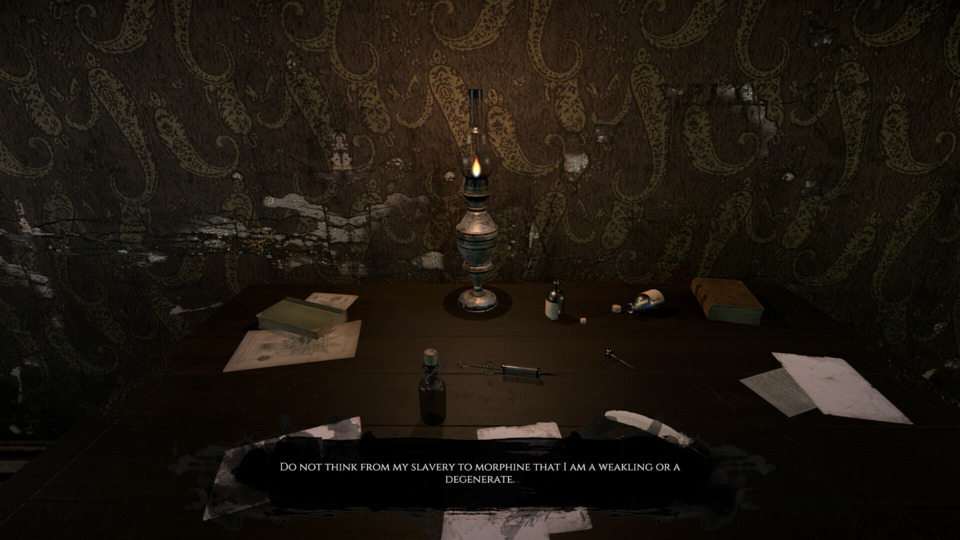
What Is It?
Dagon: by H. P. Lovecraft, is the first episode of a series of modern interactive fiction works from developer Bit Golem, whom most people remember as the outfit that made Ultimate Fishing Simulator. With Dagon, you get a free 3D retelling of the similarly named short story from H. P. Lovecraft condensed into a thirty to forty-minute experience. The game will plop you into an environment, have a narrator read lines from the source material, and direct you to either search for hidden Easter Eggs or continue to the next scene. There is no free movement. Instead, you move the camera around and use your mouse to zoom in on objects and parts of the environment to search for those secrets I mentioned earlier. Most of the time, you need to find an article of clothing folded in the background or a piece of furniture and click on your mouse to zoom in on it before it unlocks an optional reading that fills in the story's historical context.
The best way to describe Dagon, and its accompanying episodes, is to call it an interactive visual novel. However, even if I accept it for what it is, I have a few issues with this project. First, the narrator sounds flat and needs more emotion, which is problematic when the game attempts to showcase some of its more ambitious visual set pieces. There was even a brief spot at the start where I thought Bit Golem was using a text-to-speech engine. Second, finding hidden secrets is incredibly fiddly. For some, you need to zoom the camera on them, whereas, for others, you can immediately click them. The use of these as a game mechanic is also debatable. If I am going into any of these episodes with the hope of getting the definitive version of these stories, needing to fan through basic 3D backgrounds while furiously clicking on stuff hurts the flow of the story. If people want to know everything there is to know about Dagon, then let them have it! A better format would have been what Valve did with their Director's Cut commentaries for The Orange Box.
Hardest/Worst Puzzles
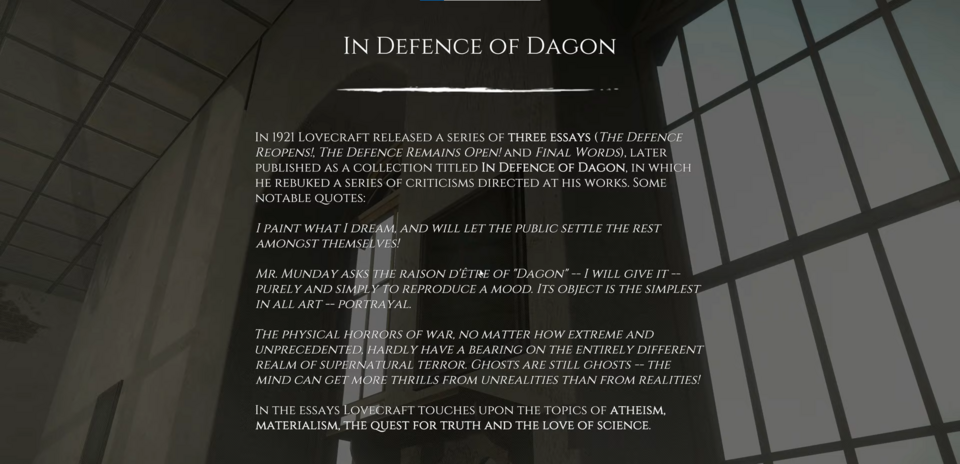
- The Collectibles (All of Them!) - Given the game's format, it comes down to those collectibles. You'd likely get frustrated if you make even the slightest effort to seek out every goodie or hidden object in the game. As I already stated, for many of these optional objects, you need to find random things and then click to zoom on them to make a glyph appear that you click again. It's not a great feeling. Most of the hidden objects feel like glorified pixel hunts. Worse, the game relying on these objects also means the environments feel incredibly limiting. Instead of interacting with horrible eldritch abominations or other NPCs, you're stuck scanning for collectibles that have nothing to add but summary writings brought to you by SparkNotes.
Recommendation: MAYBE GIVE IT A SHOT - Dagon is meant to be a love letter to those who adore everything Cthulhu and Lovecraft. Dagon promises to be a "100% faithful adaptation of the original story," and it delivers on that promise. Is that enough to make the episodes that cost money a worthwhile proposition to people who enjoy the works of H.P. Lovecraft? I don't think so. All the Easter Eggs I mentioned add are excerpts of information that feel like abbreviated articles from Wikipedia. Taking the effort to discover everything each episode has to add doesn't provide new interpretations you were unaware of if you are a fan of Lovecraft's works. Likewise, while these articles are happy to discuss Lovecraft's struggles with drug abuse and mental health, there's no mention of him being a horrible racist. But ultimately, your ability to overlook the underutilization of the environments, fiddly collectibles, and the fact it brings nothing new to the table depends on how much you enjoy or support the works of H.P. Lovecraft.
Fall of Porcupine: Prologue
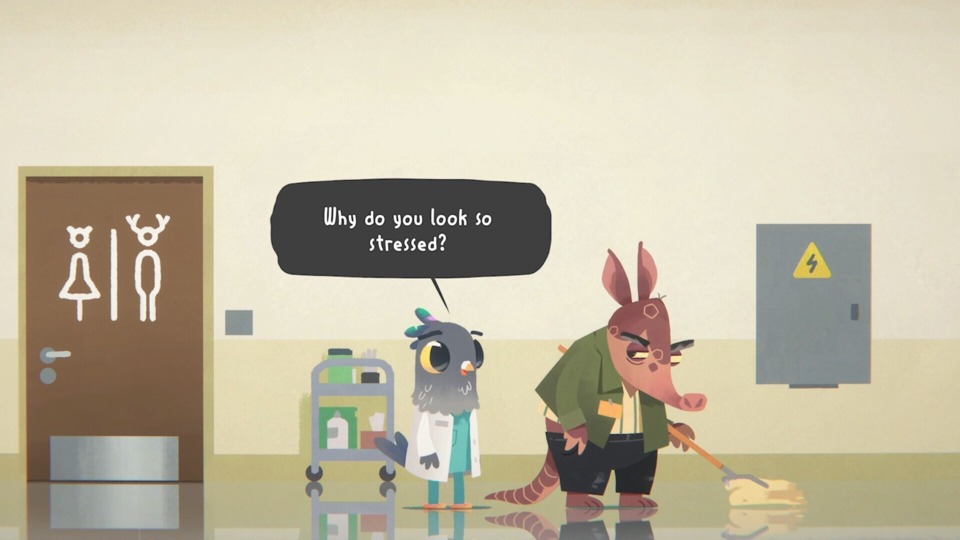
What Is It?
Fall of Porcupine is a story-based adventure game in the style and spirit of Night in the Woods. Much like Night in the Woods, it utilizes hand-drawn background and character models and mixes platforming, puzzle solving, and mini-games in-between character-based story moments. The subject with Fall of Porcupine is that you control a doctor named Finley, who has recently finished their residency and is starting their first full-time medical job as a general practitioner or internist. On the story front, Fall of Porcupine mixes commentary about the state of the medical profession and its many insurmountable challenges with slice-of-life comedy and fantastical self-reflections. Near the end of the free prologue, which you can get on various digital marketplaces, and not just GOG, it teases a thematic shift towards a darker mystery. I will not spoil this "twist," but I will say that while I started to tire of the game as it felt increasingly listless, the twist at the end did enough to get me back on board with the finished product, which is slated for a Q2 2023 release.
We should address the "Prologue" portion of this game's title, considering I started this blog by saying I was not playing demos. We still do not know what shape or form the "full" game will take. For all I know, it could utilize the episodic format that Kentucky Route Zero took, or it might be a full-fledged release with no additional DLC or episodes. What you get with Fall of Porcupine: Prologue is a one to two-hour vertical slice the developer has stated is the game's introduction. It stops at a perfect spot and feels a lot like the pilot of a new television program. This prologue doesn't beat you over the head with a time limit, and you can interact with every NPC or object that surrounds Finley without fear of reprisal. You also get a clear understanding of how the game will play, and as a result, it feels enough like a standalone product that I thought it was worth including in this mini-series.
Hardest/Worst Puzzles
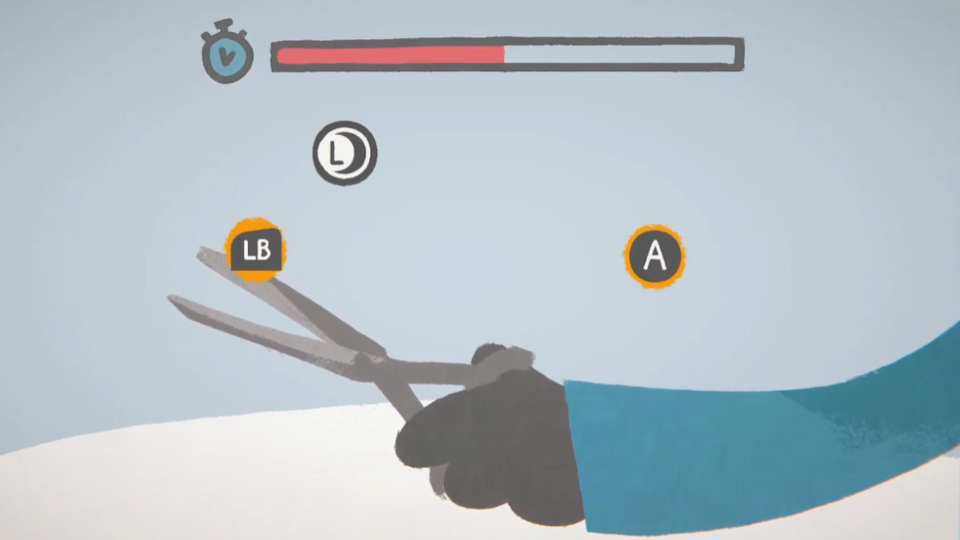
- Using Mastermind To Make Medical Diagnoses - HOLY SHIT, I hope the developers of Fall of Porcupine reconsider some of these mini-games! To make you feel the doldrums of being a doctor in a dilapidated and highly neglected medical facility, Fall of Porcupine has you complete an assortment of mini-games while performing the essential duties of being an internist. As we will review shortly, some of these mini-games will likely remind you of Trauma Center. However, one of my least favorites was the version of Mastermind you play when figuring out new hospital residents' ailments. It's not hard, but needing to play the same plodding mini-game every time I have to make a diagnosis does not have me leaping with joy. Part of what the game is trying to accomplish is how dysfunctional and exhausting it is to be in the medical profession. However, having THE MOST vanilla-ass process of elimination puzzle communicate that point is a massive misstep because it's so predictable you can quickly burn through them and miss that point entirely.
- The Trauma Center-Inspired Mini-Games When Performing Medical Procedures - If you play Mastermind to diagnose patients, then what do you do when you need to help them get healthy? Why Fall of Porcupine makes you play an onslaught of Quick Time Events! Whenever Finley needs to perform a medical procedure, a random series of button prompts will appear on the screen. You must click and hold each button prompt as it appears until the entire sequence is held together for a few seconds before a new sequence plays. You perform this controller or keyboard-based limbo act at least three times before completing a procedure. The comparisons to Trauma Center write themselves, but at least Trauma Center has a variety with its mini-games and what it expects you to perform. Fall of Porcupine uses the same mini-game type for almost everything, and that dulls the impact of its message of its characters being overwhelmed with tasks they barely feel capable of performing. There's no sweat-induced tension like with Trauma Center, which feels like a missed opportunity.
- The Bar Fight Fighting Mini-Game - This mini-game came out of nowhere and stuck out like a sore thumb. While Finley and his friends hang out in a bar, they get into a fight with another patron. This tussle plays out like a Kongregate flash game, with you able to attack, block, and use a special move. I tried this mini-game about three times and lost each time, and I suspect that is what the game wants. However, thematically, it feels schlocky and comical at a point when the game is trying to be self-reflective and meditative. I hope the developers understand they don't need to force interactive elements like these during long storytelling breaks in the game's final version. Just let the characters be.
Recommendation: SURE, GIVE IT A SHOT - For those who enjoyed Night in the Woods, I think you should give this prologue a shot to see if the final product seems like something you'd like to see in the future. Admittedly, it's far from perfect, and I hope the developers take the input they are receiving from this prologue to heart. However, at slightly north of one hour, anyone interested to see the complete game will figure that out by the time they roll credits with this first episode. You get a perfect gauge of who the characters are and what their initial internal struggles might be.
Delores: A Thimbleweed Park Mini-Adventure
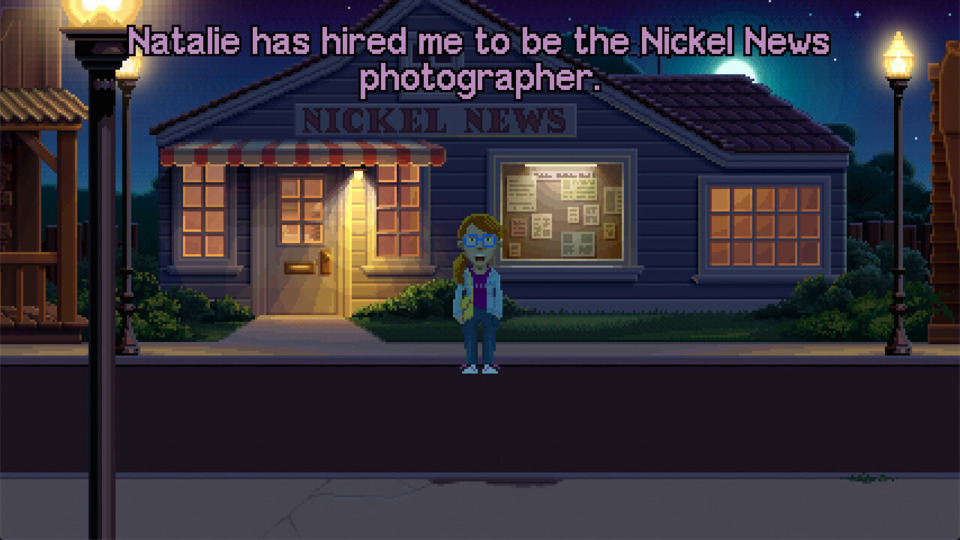
What Is It?
Alright, Delores: A Thimbleweed Park Mini-Adventure is a weird thing requiring some explanation. This "Mini-Adventure" is a prototype Ron Gilbert and his team made while tinkering around with the custom game engine they created for Thimbleweed Park. It is NOT a proper sequel to Thimbleweed Park and lacks much of the polish that made Thimbleweed Park one of the highlights of 2017 when it was first released. You will not find voice acting, and the story doesn't kick in until the end. What it does have are original art assets explicitly made for this prototype, and its mission structure is certainly unorthodox compared to the original. The premise of this game is that you control Delores Edmund, as she works as a photographer for the Thimbleweed Nickel News. The newspaper's editor provides her with a checklist of five photographs she wants Delores to take, but the assignments are in riddles. There are thirty to capture, but after collecting five, you need to quit the game and reload it before it provides Delores with her next assignment. For those who have played Thimbleweed Park, this makes a lot of sense and is EXACTLY what you think.
After publishing this game for free, Ron Gilbert has since used it as an on-ramp for those who have yet to play or purchase Thimbleweed Park. As I will review at the end, I could not disagree more with that decision. Delores: A Thimbleweed Park Mini-Adventure is trying to do things gameplay-wise that are different enough from the original game that playing it does not build a sense of competency with its mechanics or engine. Likewise, this mini-adventure is more challenging and rougher than Thimbleweed Park because it is trying to do things outside the purview of its engine and development team. Also, and this is the bigger problem, it spoils the plot revelation in Thimbleweed Park, which is the soul of that game and its characters. You should, under NO CIRCUMSTANCES, play this before you play the original game!
Hardest/Worst Puzzles
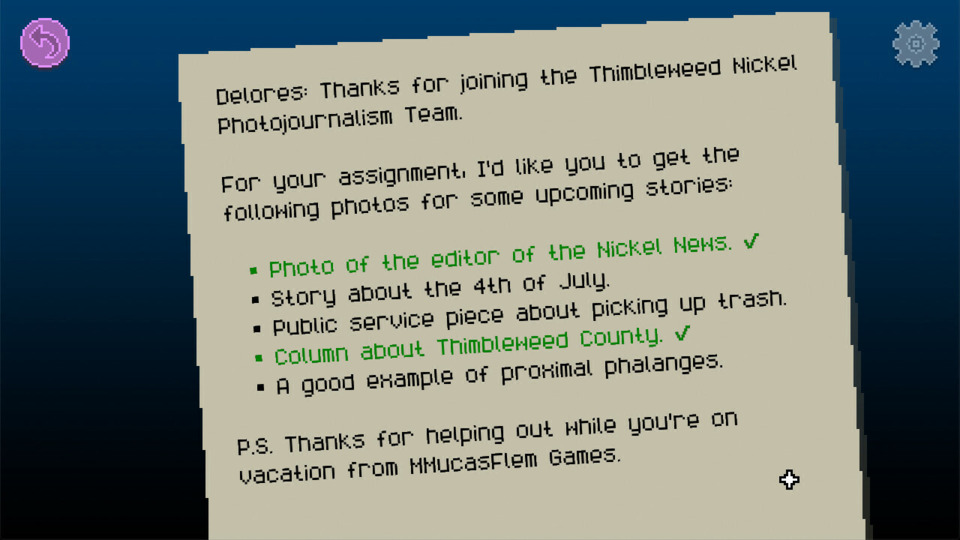
- A Story On Demolition - Ron Gilbert LOVES using fetch quests, and we have known that to be the case for almost forty years. Something I wish to add as a positive about this prototype is that Gilbert's team experimented with having more than one possible solution to puzzles, and this is one of a handful of examples. Unfortunately, given the game's reset-focused nature, you often must perform the same tasks more than once. In this case, you must help Delores's sister, Lenore, take up a job at a bank, which is a task you perform at least two times. You do this by examining a notice that the bank is closed and handing that notice to Lenore. Once inside the bank, you pick up a "dangerous dövice" and need to find a way to charge its batteries. You can use a screwdriver on a radio or an electrical plug to accomplish that. Once set, you can use the device at the top of a hill and photograph a radioactive crater. It's far from impossible, but needing to pick the same objects repeatedly is such an annoyance.
- A Story About President Thomas Jefferson - I feel like the lack of clarity with this puzzle is a clear-cut case of this game being a prototype. When you get the task of finding a photo for a story about Thomas Jefferson, your first thought might be to go to the library and find a book about him. You'd be wrong, and that seems ripe for an alternate puzzle solution the team behind this project was apt to include elsewhere. Instead, you need to pick up a bottle next to the fortune teller's shop, hand the bottle to a different store owner to collect a nickel, and photograph the nickel. I have yet to play a single game by Ron Gilbert that didn't have at least one puzzle that was a little too fond of red herrings, and this game doesn't buck that trend.
- A Story About Allergies - This task is, BY FAR, the worst in the game and I cannot believe they recycled this mission from the original game. I hated it there, and I hate it here! Your mission here is to show how the air quality in Thimbleweed Park has worsened thanks to a spike in allergens and recent industrial activity. You do that by picking up dust specs until you have ten to photograph a complete dust ball. There are two problems. First, the dust specs are exactly one pixel big and are sometimes easily obscured by objects in the foreground or background. Second, these dust specs randomly spawn and do not have fixed locations. Because items do not carry over between playthroughs, you can only collect these dust particles when the game provides the appropriate mission, which means you'll likely have to resort to aimless wandering until you gather enough to complete this particular task.
Recommendation: MAYBE CHECK THIS OUT - Once again, I stand by my firm exclamation that anyone who has yet to play Thimbleweed Park should avoid this outing until AFTER they play the base game. While the ending of this mini-adventure is brief and far from explicit, it does enough to peel away the mystique and shock factor of the original. This point must mean this game is an easy recommendation for people who love Thimbleweed Park, right? Well, here's the issue with that. While I think most fans of Thimbleweed Park will be able to discern "the deal" with this game, it doesn't add or go deep enough to make it an essential companion piece. Its difficulty curve and occasional rough edges make it an awkward project when placed next to its predecessor. That's not to suggest that you won't be able to have a good time with it, but you have to adjust your expectations and understand it is a prototype that likely will never become a full-fledged commercial title.
Samorost 1
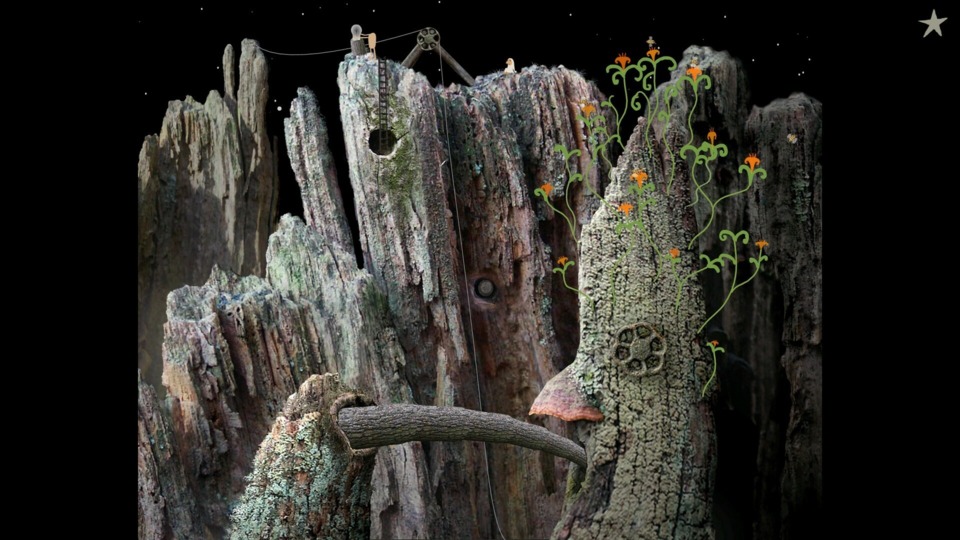
What Is It?
Samorost (i.e., Samorost 1) is the first title from Amanita Design, the developer behind games like Machinarium, Botanicula, and Chuchel. Amanita figurehead Jakub Dvorský created Samorost while they were still a student at the Academy of Arts, Architecture, and Design in Prague. The game is short and largely simplistic, with you needing to assist a gnome in avoiding a collision between their home planet and a spaceship. As you explore different backdrops and environments, you use musical and environmental clues to figure out how to move from one screen to the next before finally resolving the game's core conflict. This game initially came out in 2003 but was remastered in 2021 to update its graphical fidelity to make it capable of playing full screen on modern monitors. The remaster also redid the music to make specific musical cues and hints easier to detect. As is the case with everything Amanita Design has made since this title, it emphasizes clicking and interacting with the objects, creatures, and people on your screen. However, there are non-verbal tells with every task the game presents which has been Amanita's modus operandi since its inception.
Hardest/Worst Puzzles
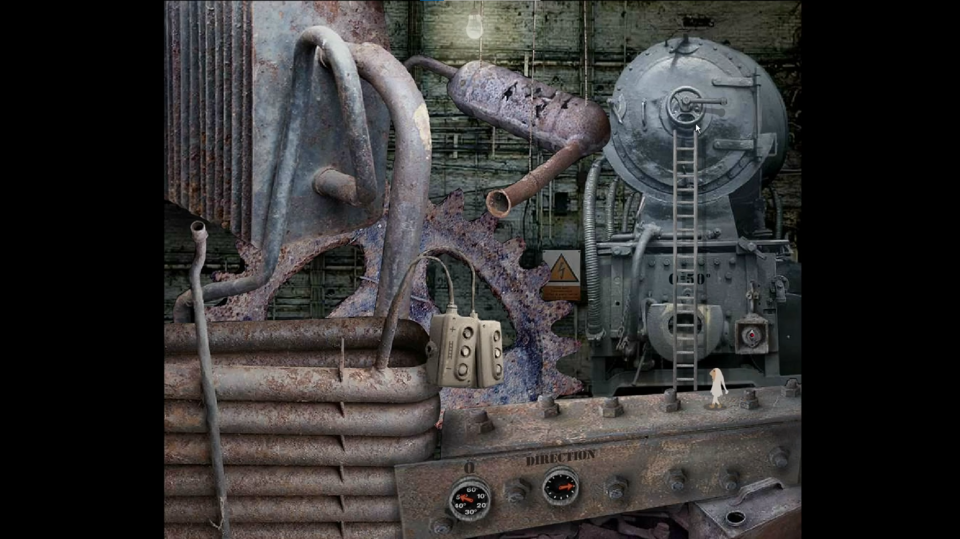
- Getting Past The Anteater - I have never been the biggest fan of Amanita Design, primarily due to my growing tiredness of their approach to puzzle design. Whenever you get stuck in one of their games, I advise clicking everything on the screen until the game lets you move forward. That's the case with Samorost 1, but an early game design struggle for them stemmed from your sense of distance or place. An example of this occurs near the penultimate screen in the game when you need to direct an ant toward an anteater blocking the entrance to an engine room. I figured out how to lead the ant to the creature, but it took me time to realize I had to be within a given distance of the creature for it to begin eating the insects to prevent it from eating my gnome character. It's not game-breaking by any means, but there are circumstances where you need to be within an uncommunicated cone of visibility with enemies and hostile targets before you can interact with them. I'm delighted they mostly got past that in later titles.
- The Engine Room - Amanita Design has bumbled with the landings of its games since its foundation. For them, they always seem to struggle with finding a balance between continuing their welcoming sense of whimsy and ratcheting up the stakes as you near the end of their games. With Samorost, there's something anti-climactic with going through one creative psychedelic landscape after another, only for that to culminate in a drab grey industrial engine room. You get the sense that Jakub Dvorský may have been a bit out of his element because the legibility of this environment is vastly worse than the rest of the game, with you needing to adjust knobs and valves to send the spaceship I mentioned earlier away from the gnome home planet. Yes, the game has signs and clear indicators of what each valve needs to be set to, but the markings on everything are monochromatic to a fault. If you have vision problems or even colorblindness, I can foresee the final sequence of this game presenting some insurmountable barriers.
Recommendation: SURE, GIVE IT A SHOT - I'm not a stalwart fan of the works of Amanita Design. Still, I have to give this game props for being short and providing an incredibly accessible snapshot of what to expect with every game they make. At $0, if you have yet to check out their works, there's no better on-ramp for gauging if their games will tickle your fancy than the first Samorost. Sure, Machinarium and Botanicula are better games, but the core of what to expect from Amanita Design is still here. Also, Samorost 1 is a historical watermark that proves how much the studio has evolved and grown. Returning to this one is worthwhile if you have only played their later works and consider yourself a fan.
CAYNE
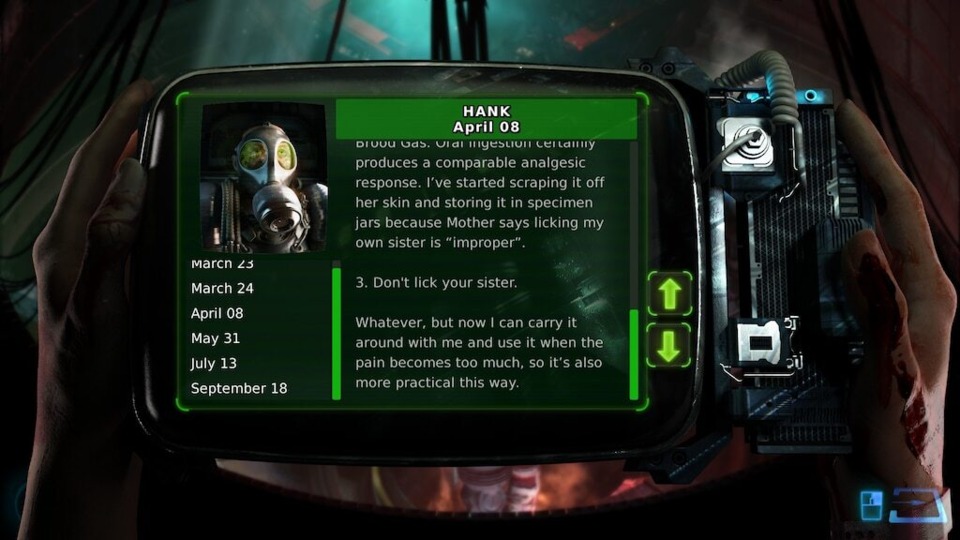
What Is It?
Cayne: A Stasis Story (i.e, CAYNE) is a standalone prequel to the 2015 horror adventure game, Stasis which was developed by The Brotherhood Games and published by Daedalic Entertainment. CAYNE is a free jumping point to discover if The Brotherhood's style of isometric point-and-click adventuring is your cup of tea. The Grammarly Editor desperately wants me to change "a free jumping point" into "an accessible jumping point," and I cannot in good conscience do that. Brotherhood Games pride themselves in making horror-themed games that are unflinchingly bleak and revel in depicting Kafkaesque downward spirals into hellish realities. Cayne is no different, with its story detailing the adventures of a woman who, at the start of the game, attempts to get an abortion, only to end up kidnapped and at the whims of an evil cult that mysteriously needs her to birth her child. An omnipotent voice speaks to the protagonist and slowly attempts to convince her, as she attempts to escape the torturous science facility she is in, not to follow through with the abortion. I should mention all of this is played "straight," and Stasis was equally discomforting with the events of its story, with one scene, in particular, sticking out to me as one of the most macabre I have seen in a modern video game. Neither game starts with a content warning, but HOT DAMN, should they!
Cayne and Stasis, to me, at the very least, highlight a reckoning or cause célèbre for modern horror adventure games. The enduring legacy of Sanitarium continues to be undeniable, with The Brotherhood actively citing it as a reason why they got into games development in the first place. While plenty of traditional adventure games pre-dated it, Sanitarium's style, storytelling structure, themes, and gameplay continue to exist as vestigial DNA in most modern horror point-and-click adventure games. With Cayne, most puzzles require reviewing tomes of knowledge and computer terminals for clues and hints on unlocking lockers, doors, or vaults. The isometric perspective, reliance on item combinations, and chapter-like format all feel lifted directly from Sanitarium. And regrettably, Cayne and Stasis's reliance on blue and offensive language and problematic depictions of mental health are no different from Sanitarium as well. I was not a massive fan of Stasis, even though I respected it for trying to take advantage of the modern adventure game revival by doing something darker and different. However, the works of The Brotherhood are not for everyone, and you should be aware of that before jumping into anything associated with them.
Hardest/Worst Puzzles
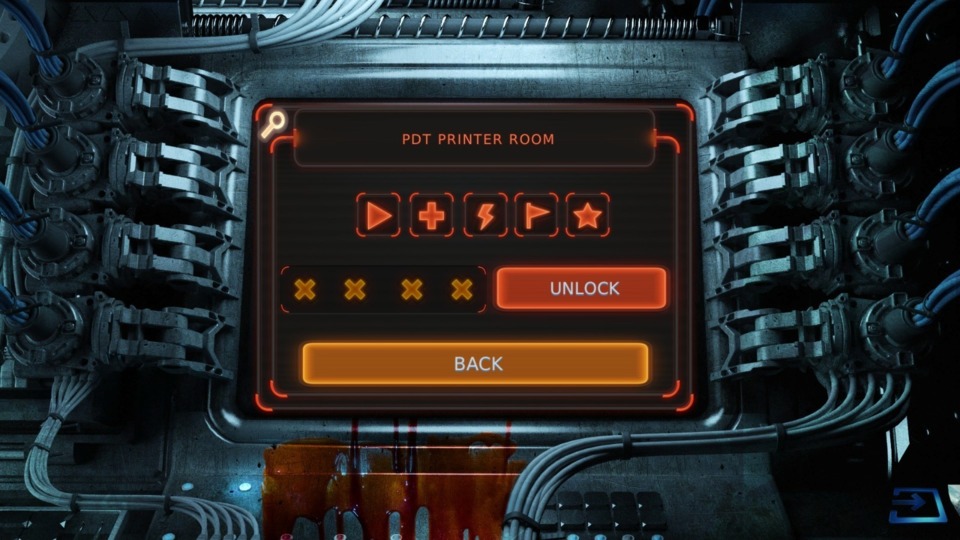
- The Eight Or Nine Times You Need To Find Passcodes Hidden In Terminals - I have always hated using catch-alls for my adventure game blogs, but considering this is a special, I will make a one-time exception. After you get past Cayne's opening chapter, you find your character stuck in a hub world with doors that are blocked by force fields. As you might expect, you need to visit each room in a specific order and find passwords that disable these barriers one at a time. That might sound alright until you consider each passcode is hidden in random computer terminals with diary posts you need to read painstakingly, one at a time. Sometimes these computer logs have upwards of fifteen to twenty entries, and the passcode is surreptitiously hidden at the butt-end of the middle or penultimate post. By the way, there's only one terminal where you can input passcodes to disable the force fields, and depending on your location, it takes FOREVER for the protagonist to get to it. The rooms also have anywhere between five to ten segmented parts, so finding the one terminal with the passcode you are looking for is sometimes challenging. This structure makes the middle act of the game feel like a complete slog.
- Using Protein Powder On a Terminal To Discover a Passcode - I'm not too fond of the often red herring lines of logic you need to follow regarding The Brotherhood's approach to item combination puzzles. A perfect example comes early in Cayne when you need to unlock a password-protected computer terminal. The password is a touch-screen-based system, and while you can attempt to brute force the answer, it's best to scour for the items that make the solution vastly easier. First, you need a mangled piece of metal that you discover to be a scalpel. Next, by a shrine, you must pick up a can that turns out to be protein powder. Using the scalpel on the tin opens the lid, and now you can apply the can to the terminal to reveal fingerprints that indicate which buttons to press to unlock the computer screen. Both quest items are small, barely flickering pixels in the environments you gather them. Finally, nothing in-game marginally suggests which objects connect to the locked terminal. It is a puzzle that only makes sense if you are the designer or consulting a guide.
- The Final Grub Habitat Puzzle - Did I mention how much I hate this game's reliance on computer terminals? For the game's final puzzle, it places a horrible alien-human hybrid monster between you and freedom. While researching this abomination, you discover that experimental grubs in a testing room secrete a noxious gas the monster finds intoxicating. However, for these insects to produce the gas, you must adjust the humidity and temperature of their habitat. The correct temperature is located in a random PDA lying on the ground of a printing room, and at the point when you first interact with it, you have no idea to write down the temperature. The information related to the correct humidity is at least in the room where the insects can be found. Still, I need help justifying the first part of this puzzle being an easily missable item, four or five steps removed from where you apply it. It is not as if the PDAs or terminals highlight story-critical text like The Legend of Zelda. Worse, dozens of PDAs only add extra storytelling flavor. Therefore, it's impossible mentally to categorize which ones are important.
Recommendation: NO, HARDPASS - I did not enjoy my time with Cayne. While I could accept Stasis at the time as a throwback to a bygone style of adventure game deliberately aimed at a mature audience, something about Cayne rubbed me the wrong way. It's an equal mix of me being aware of The Brotherhood's problematic storytelling crutches and my tiredness with their go-to gameplay tricks. It's still a free title you are free to check out if you have an interest in playing something that errs towards the macabre, but even then, some of the fiddlier aspects of how to play it are bound to annoy you. Luckily, it's a game that tops out in under three hours if you know what you are doing.
Log in to comment